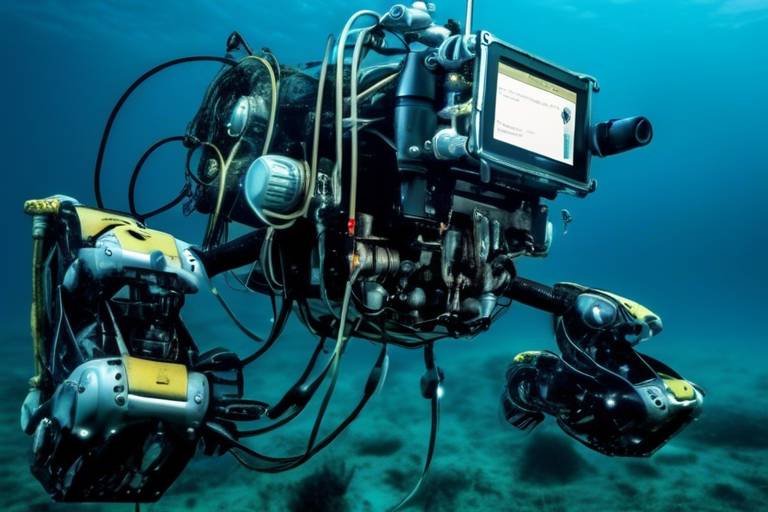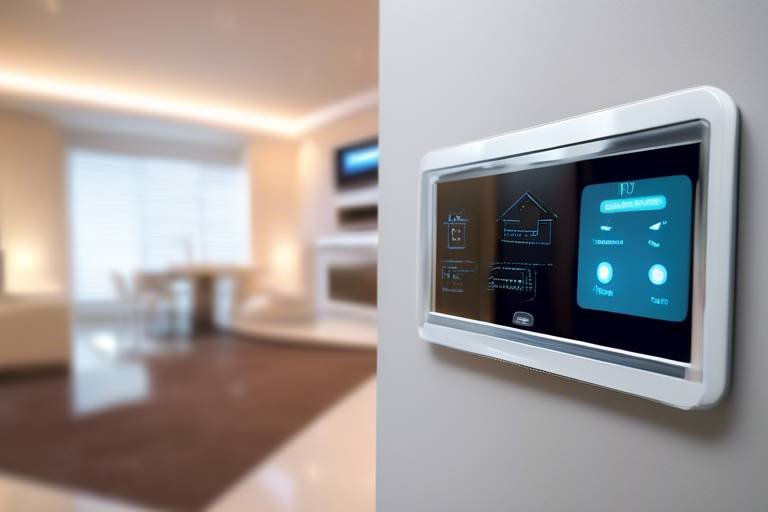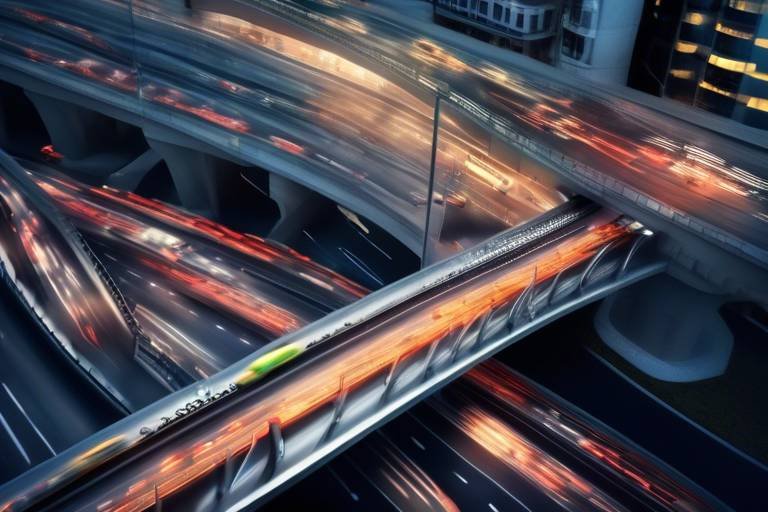The Role of Robotics in Underwater Exploration
Underwater exploration has long been a frontier of human curiosity and scientific inquiry, and in recent years, robotics has emerged as a powerful ally in this quest. Imagine descending into the deep blue, where sunlight barely penetrates, and the mysteries of the ocean floor await discovery. Robotics has not only made this possible but has also transformed how we understand and interact with our marine environments. In this article, we will dive into the significant impact of robotics on underwater exploration, highlighting the advancements that have propelled this field, the various types of underwater robots, and the exciting future that lies ahead.
Robots have the ability to venture into depths that are inhospitable to human divers, allowing researchers to gather data from previously unreachable locations. The advent of advanced sensors and the development of more robust materials have made it possible for these machines to withstand extreme pressures and temperatures. With every dive, they collect invaluable information that helps scientists monitor ecosystems, study marine life, and even assess the impacts of climate change. The role of robotics in underwater exploration is not just about exploration; it’s about understanding our planet and preserving its delicate balance.
As we navigate through this article, we will uncover the various types of underwater robots, such as Remotely Operated Vehicles (ROVs) and Autonomous Underwater Vehicles (AUVs), each designed with specific capabilities to tackle unique challenges. We will also address the environmental implications of deploying these robots and how they contribute to conservation efforts. The future promises even greater advancements, particularly with the integration of artificial intelligence and machine learning, which will further enhance the efficiency and effectiveness of underwater exploration technologies.
Recent innovations in robotics have revolutionized underwater exploration, enabling researchers to access previously unreachable depths and gather valuable data on marine ecosystems. The evolution of underwater robotics has been remarkable, characterized by the development of sophisticated technologies that enhance our ability to explore and understand the ocean.
There are various types of underwater robots, including remotely operated vehicles (ROVs) and autonomous underwater vehicles (AUVs), each designed for specific tasks and environments in marine exploration. These robots are equipped with cutting-edge technology that allows them to perform a variety of functions, from simple observation to complex data collection.
ROVs are controlled from the surface and equipped with cameras and tools, making them ideal for real-time exploration and intervention in underwater environments. They serve as the eyes and hands of researchers, allowing them to conduct detailed inspections of underwater structures, such as oil rigs and shipwrecks.
ROVs are extensively used in oil and gas exploration, underwater construction, and scientific research, showcasing their versatility and importance in various marine industries. Their ability to operate in hazardous environments while providing high-definition video feeds makes them indispensable tools for professionals in the field.
Operating ROVs in extreme underwater conditions presents challenges such as communication delays, power limitations, and the need for robust design to withstand pressure. These challenges require constant innovation and adaptation to ensure that ROVs can perform effectively in the depths of the ocean.
AUVs operate independently, equipped with sensors to collect data over large areas, making them crucial for mapping and monitoring marine environments. Unlike ROVs, which are tethered to a surface vessel, AUVs can travel long distances autonomously, gathering data on temperature, salinity, and other critical oceanographic parameters.
The deployment of underwater robots raises concerns about their environmental impact, necessitating careful consideration of their effects on marine life and ecosystems. While these technologies offer significant benefits, it’s important to balance exploration with conservation.
Underwater robotics significantly enhance data collection capabilities, providing insights into oceanographic phenomena and contributing to our understanding of climate change. By mapping the ocean floor and monitoring marine species, researchers can track changes in biodiversity and assess the health of marine ecosystems.
Robotic technologies play a vital role in conservation efforts, helping monitor endangered species and assess the health of marine habitats. By utilizing AUVs and ROVs, conservationists can gain a better understanding of the challenges facing marine life and develop strategies to protect these vulnerable ecosystems.
The future of underwater robotics is promising, with advancements in AI and machine learning set to enhance the efficiency and capabilities of marine exploration technologies. As these technologies continue to evolve, we can expect to see even more sophisticated robots capable of performing complex tasks with minimal human intervention.
Integrating AI with underwater robotics will enable smarter decision-making and more autonomous operations, improving data analysis and exploration outcomes. This synergy will allow robots to adapt to changing conditions in real-time, making them more effective in dynamic underwater environments.
The future may also see increased collaboration between human divers and robots, combining human intuition with robotic precision to tackle complex underwater challenges. This partnership could lead to groundbreaking discoveries and advancements in our understanding of the ocean.
- What are the main types of underwater robots? The main types include Remotely Operated Vehicles (ROVs) and Autonomous Underwater Vehicles (AUVs), each serving different purposes in exploration.
- How do underwater robots collect data? Underwater robots are equipped with various sensors and cameras that allow them to collect data on environmental conditions, marine life, and underwater structures.
- What are the environmental impacts of using underwater robots? While they provide valuable data for conservation, their deployment must be managed carefully to minimize disturbances to marine ecosystems.
- How is AI used in underwater robotics? AI enhances the decision-making capabilities of underwater robots, enabling them to operate autonomously and adapt to changing underwater conditions.

Advancements in Underwater Robotics
Recent innovations in robotics have truly revolutionized the field of underwater exploration. Imagine being able to dive into the depths of the ocean without getting wet, or exploring shipwrecks and coral reefs from the comfort of a control room on a ship! Thanks to advancements in robotics, researchers can now access previously unreachable depths and gather invaluable data on marine ecosystems. These breakthroughs are not just about technology; they represent a profound leap in our understanding of the underwater world.
One of the most significant advancements is the development of high-definition cameras and sensors that can withstand extreme underwater pressure. These tools allow for real-time data transmission, enabling scientists to observe marine life and geological formations in stunning detail. Moreover, the integration of advanced materials and engineering techniques has led to the creation of more durable and efficient underwater vehicles. For instance, the use of lightweight composites and corrosion-resistant materials has improved the longevity and performance of these robots.
Furthermore, the advent of machine learning and artificial intelligence has transformed how underwater robotics operate. These technologies enable robots to analyze data and make decisions autonomously, significantly enhancing their efficiency. For example, AUVs can now autonomously navigate complex underwater terrains, avoiding obstacles and adjusting their paths based on real-time data. This capability not only saves time and resources but also minimizes the risk of human error during underwater missions.
Another exciting development is the collaboration between various robotics systems. Researchers are increasingly employing a combination of ROVs and AUVs to tackle complex tasks. This synergy allows for a more comprehensive approach to exploration, as one robot can gather data while another performs interventions or repairs. The result? A more thorough understanding of marine environments and the ability to address challenges that arise during exploration.
In summary, the advancements in underwater robotics are opening up new frontiers in marine research. From enhanced imaging capabilities to autonomous navigation and collaborative systems, these innovations are not just impressive feats of engineering; they are essential tools that help us unlock the mysteries of our oceans. As we continue to push the boundaries of technology, who knows what incredible discoveries await us beneath the waves?

Types of Underwater Robots
When we dive into the fascinating world of underwater exploration, we encounter a variety of robotic technologies designed to navigate the mysterious depths of our oceans. These robots are not just toys for scientists; they are sophisticated tools that allow us to unlock the secrets of marine ecosystems. Among the most prominent types of underwater robots are Remotely Operated Vehicles (ROVs) and Autonomous Underwater Vehicles (AUVs). Each type has its unique capabilities and applications, tailored to meet the challenges posed by the underwater environment.
ROVs are like the eyes and hands of ocean explorers. Controlled from the surface, these vehicles are equipped with high-definition cameras and specialized tools that enable them to perform tasks in real-time. Imagine having a robotic assistant that can dive down to significant depths, capture stunning images, and even manipulate objects—all while you sit comfortably on a boat or in a control room. This capability makes ROVs invaluable for tasks such as underwater construction, scientific research, and even search-and-rescue operations. The versatility of ROVs is evident in their ability to adapt to various missions, from inspecting oil rigs to studying coral reefs.
On the other hand, AUVs operate more like autonomous explorers, venturing into the depths without direct human control. These robots are equipped with advanced sensors that allow them to collect data over vast areas, making them essential for mapping the ocean floor and monitoring marine environments. Imagine sending a robot on a mission to gather data about temperature, salinity, and marine life across hundreds of kilometers without needing a tether to the surface. AUVs excel in this regard, providing researchers with a wealth of information that would be nearly impossible to gather manually.
To give you a clearer picture of the differences between ROVs and AUVs, here's a quick comparison:
| Feature | Remotely Operated Vehicles (ROVs) | Autonomous Underwater Vehicles (AUVs) |
|---|---|---|
| Control | Surface-controlled | Autonomous |
| Data Collection | Real-time data streaming | Pre-programmed data collection |
| Applications | Construction, inspection, research | Mapping, monitoring, surveying |
| Mobility | Limited by tether | Free movement |
Both ROVs and AUVs play crucial roles in underwater exploration, each complementing the other in various marine research scenarios. While ROVs provide immediate feedback and control, AUVs offer the ability to cover larger areas over extended periods. Together, they represent the cutting edge of underwater robotics, pushing the boundaries of what we can learn about our planet's oceans.
As technology continues to advance, we can expect even more sophisticated underwater robots to emerge, equipped with enhanced sensors, improved AI capabilities, and greater autonomy. The future of underwater exploration is bright, and these robots will undoubtedly lead the way in uncovering the mysteries that lie beneath the waves.
- What are the main differences between ROVs and AUVs? ROVs are controlled from the surface and provide real-time data, while AUVs operate autonomously and collect data over vast areas without direct human intervention.
- What types of tasks can ROVs perform? ROVs can perform a variety of tasks including underwater construction, inspection of marine structures, and scientific research, thanks to their equipped tools and cameras.
- How do AUVs contribute to marine research? AUVs contribute by autonomously collecting data on oceanographic conditions, mapping the seafloor, and monitoring marine ecosystems, which is crucial for understanding climate change and marine health.

Remotely Operated Vehicles (ROVs)
Remotely Operated Vehicles, commonly known as ROVs, have become a cornerstone of underwater exploration. Imagine being able to explore the depths of the ocean, witnessing the vibrant life that thrives there, all without getting wet! ROVs are essentially underwater robots that are controlled from the surface, allowing researchers and operators to navigate through challenging environments while keeping a safe distance. These vehicles are equipped with high-definition cameras, sensors, and various tools, making them incredibly versatile for a multitude of tasks.
One of the most compelling aspects of ROVs is their ability to operate in real-time. This means that operators can see what the ROV sees as it maneuvers through the water, making it possible to make immediate decisions based on live feedback. This feature is particularly valuable in scenarios like underwater construction or maintenance, where quick adjustments can be crucial. The ability to manipulate tools remotely allows for precision work in environments that are otherwise too dangerous or inaccessible for human divers.
ROVs are not just toys for ocean enthusiasts; they play an essential role in various industries. Here are some significant applications:
- Oil and Gas Exploration: ROVs are extensively used to inspect underwater pipelines and drilling rigs, ensuring safety and operational efficiency.
- Scientific Research: Marine biologists and oceanographers rely on ROVs to study ecosystems, gather samples, and monitor marine life.
- Underwater Construction: These vehicles assist in the assembly and maintenance of structures like offshore wind farms and underwater cables.
However, operating ROVs is not without its challenges. The underwater environment is harsh, and ROVs must withstand significant pressure, cold temperatures, and sometimes turbulent currents. Communication delays can occur due to the vast distances between the surface and the vehicle, which can complicate operations. Additionally, the power limitations of ROVs often restrict their operational time, necessitating efficient energy management and innovative design solutions.
In summary, ROVs are a remarkable blend of technology and engineering, allowing us to explore and interact with underwater environments like never before. Their ability to provide real-time data and perform complex tasks makes them invaluable in a variety of fields, from scientific research to industrial applications. As technology continues to evolve, we can only expect ROVs to become even more sophisticated and capable, pushing the boundaries of what we can discover beneath the waves.
- What is the primary purpose of ROVs? ROVs are primarily used for underwater exploration, inspection, and data collection across various industries, including oil and gas, scientific research, and underwater construction.
- How deep can ROVs operate? The operational depth of ROVs varies widely based on their design, but many are capable of reaching depths of over 3,000 meters (about 9,800 feet).
- Are ROVs used in military applications? Yes, ROVs are sometimes used for military purposes, including surveillance, reconnaissance, and mine detection operations.

Applications of ROVs
Remotely Operated Vehicles (ROVs) have carved a niche for themselves in a variety of fields, showcasing their versatility and importance in marine industries. These sophisticated machines are not just toys for ocean exploration; they are powerful tools that assist scientists, engineers, and researchers in gathering critical information from the depths of our oceans. Imagine being able to explore the underwater world without getting wet! That's exactly what ROVs allow us to do.
One of the most significant applications of ROVs is in the oil and gas industry. These vehicles are deployed to inspect underwater pipelines and infrastructure, ensuring that everything is functioning correctly and safely. They can navigate through challenging environments, providing real-time video feeds and data to operators on the surface. This capability is crucial for preventing environmental disasters, as early detection of leaks or structural issues can save both money and ecosystems.
In addition to their role in the energy sector, ROVs are instrumental in underwater construction projects. Whether it’s laying cables for telecommunications or constructing artificial reefs, these vehicles can perform delicate tasks that would be too dangerous or impractical for human divers. Equipped with specialized tools, ROVs can manipulate objects, conduct repairs, and even assist in the deployment of other underwater technologies.
Scientific research is another domain where ROVs shine. They allow marine biologists to study underwater ecosystems without disturbing the natural habitat. By capturing high-definition footage and collecting samples, ROVs help scientists understand the behaviors and interactions of marine life. For instance, researchers can observe the spawning habits of fish or the health of coral reefs, providing invaluable data that can inform conservation efforts.
Moreover, ROVs are vital in search and recovery missions. When a vessel sinks or an aircraft crashes into the ocean, ROVs can be deployed to locate wreckage and retrieve important evidence. Their ability to operate at great depths and in harsh conditions makes them indispensable in these high-stakes scenarios.
To summarize, the applications of ROVs are vast and varied, impacting several industries. Here’s a quick overview:
| Application | Description |
|---|---|
| Oil and Gas Exploration | Inspection of underwater pipelines and infrastructure to prevent leaks and ensure safety. |
| Underwater Construction | Assisting in laying cables and constructing artificial reefs with precision. |
| Scientific Research | Studying marine ecosystems and collecting samples without disturbing habitats. |
| Search and Recovery | Locating wreckage and retrieving evidence from the ocean floor. |
As we continue to innovate and improve ROV technology, the potential applications are only set to expand. From enhancing our understanding of the ocean to ensuring the safety of our underwater infrastructure, ROVs are truly revolutionizing how we interact with the deep blue sea.
- What is an ROV? - A Remotely Operated Vehicle (ROV) is an uncrewed robot that is controlled from the surface and used for underwater exploration and tasks.
- How deep can ROVs operate? - ROVs can operate at varying depths, with some models capable of reaching depths of over 6,000 meters.
- Are ROVs safe to use? - Yes, ROVs are designed to operate in extreme conditions, and they minimize the risks associated with human divers.
- Can ROVs collect data? - Absolutely! ROVs are equipped with cameras and sensors that allow them to collect valuable data for research and monitoring.

Challenges Faced by ROVs
Operating Remotely Operated Vehicles (ROVs) in the deep blue sea is not as simple as it might seem. While these technological marvels have transformed underwater exploration, they come with their own set of challenges that can make even the most experienced operators pull their hair out! Imagine trying to communicate with someone who is a hundred meters below the surface, surrounded by water that can crush steel. This is the reality for ROV operators.
One of the most significant challenges is communication delays. When sending commands to an ROV, signals must travel through water, which slows down the response time considerably. This delay can be particularly problematic during critical operations, such as when an ROV is attempting to manipulate objects or conduct repairs. The operator must often anticipate the ROV’s movements, which can be a bit like trying to dance with someone who is always a step behind.
Another hurdle is the power limitations of these vehicles. ROVs rely on tethered power sources, which can restrict their mobility and range. The longer the tether, the more susceptible it is to tangling or damage from underwater currents. This limitation can hinder exploration efforts, especially in areas where the terrain is rugged or unpredictable. Operators often have to balance the need for power with the need for maneuverability, creating a constant tug-of-war.
Moreover, ROVs must be designed to withstand the immense pressure found at great depths. As you dive deeper, the pressure increases dramatically, which can lead to structural failures if the ROV is not engineered to handle those conditions. This is akin to sending a balloon into a deep pool; if the balloon isn't strong enough, it will simply collapse under the weight of the water. Engineers must carefully consider materials and designs to ensure that ROVs can operate effectively in these harsh environments.
Lastly, there is the challenge of environmental adaptability. Underwater environments can vary dramatically, from murky waters filled with sediment to crystal-clear depths. ROVs must be equipped with advanced sensors and cameras to navigate these changing conditions. If an ROV is not properly calibrated for its surroundings, the data collected can be compromised, leading to inaccurate results in research or exploration.
In summary, while ROVs are invaluable tools in underwater exploration, they face a series of challenges that require innovative solutions. From communication delays and power limitations to pressure resistance and environmental adaptability, each issue adds a layer of complexity to underwater missions. As technology advances, overcoming these challenges will be crucial for the continued success of ROVs in marine research and industry.

Autonomous Underwater Vehicles (AUVs)
Autonomous Underwater Vehicles, or AUVs, represent a groundbreaking leap in the field of marine exploration. Unlike their remotely operated counterparts, AUVs are designed to operate independently, allowing them to navigate the vast and often treacherous depths of our oceans without human intervention. These remarkable machines are equipped with advanced sensors and sophisticated software, enabling them to collect a wealth of data over extensive areas. Imagine sending a robot on a mission to explore the ocean floor while you sip coffee on a beach—this is the magic of AUVs!
One of the most compelling features of AUVs is their ability to cover large distances efficiently. They can be programmed to follow specific paths and collect data on various parameters such as temperature, salinity, and even underwater topography. This capability is crucial for mapping marine environments, which can often be as complex and varied as the landscapes we see on land. For instance, AUVs can dive to depths of over 6,000 meters, exploring regions that were once considered unreachable.
Moreover, AUVs play a vital role in scientific research, particularly in studying phenomena such as ocean currents, climate change, and marine biodiversity. By gathering data autonomously, they free up human resources for other important tasks, such as analyzing the information collected or conducting on-site research. In essence, AUVs are not just tools; they are partners in our quest to understand the mysteries of the deep blue sea.
However, the deployment of AUVs is not without its challenges. Navigating underwater environments poses unique obstacles, such as unpredictable currents and varying water temperatures that can affect sensor performance. Additionally, the depth at which AUVs operate can lead to communication challenges, making it difficult to control them in real-time. To tackle these issues, engineers are continuously innovating, developing more resilient designs and improving navigation algorithms to ensure AUVs can operate effectively in diverse conditions.
In summary, AUVs are revolutionizing underwater exploration by providing unparalleled access to the ocean's depths, enhancing our understanding of marine ecosystems, and contributing significantly to scientific research. As technology advances, we can only anticipate even greater capabilities and applications for these remarkable vehicles.
- What are Autonomous Underwater Vehicles (AUVs)?
AUVs are robotic devices designed to operate underwater without direct human control, equipped with sensors for data collection. - How deep can AUVs operate?
Many AUVs can dive to depths exceeding 6,000 meters, exploring areas that are otherwise inaccessible. - What kind of data can AUVs collect?
AUVs can gather data on temperature, salinity, underwater topography, and various other oceanographic parameters. - What are the main challenges faced by AUVs?
Challenges include navigating unpredictable underwater currents, communication difficulties, and ensuring sensor accuracy in varying conditions.

Environmental Impact of Underwater Robotics
The deployment of underwater robots has sparked a significant discussion regarding their environmental impact. As we venture deeper into the ocean's depths with these technological marvels, it's crucial to understand both the potential benefits and the risks they pose to marine ecosystems. While these robots are designed to assist in exploration and research, their presence can inadvertently affect the delicate balance of underwater life. For instance, the noise generated by ROVs and AUVs can disrupt marine species, especially those that rely on sound for communication and navigation. Imagine a bustling underwater city where the rhythmic sounds of marine life are suddenly interrupted by the mechanical hum of a robot; it can be quite unsettling for the inhabitants.
Moreover, the physical presence of these machines can lead to habitat disturbance. When a robot traverses the ocean floor, it may inadvertently damage coral reefs or disturb sediment, which can have cascading effects on local biodiversity. This is akin to a bulldozer rolling through a pristine forest; the aftermath can be devastating. Therefore, researchers and engineers are now faced with the challenge of designing environmentally friendly robots that minimize their footprint while maximizing their research capabilities.
To address these concerns, several strategies are being implemented:
- Noise Reduction Technologies: Engineers are focusing on developing quieter robots that reduce sound pollution in marine environments.
- Adaptive Navigation Systems: These systems allow robots to navigate around sensitive areas, thereby avoiding habitats that are critical to marine life.
- Impact Assessments: Before deploying underwater robots, thorough assessments are conducted to understand the potential effects on local ecosystems.
Furthermore, the role of underwater robotics in conservation efforts cannot be overlooked. These technologies provide valuable data that can help monitor the health of marine environments. For example, robotic systems equipped with advanced sensors can track changes in water quality, temperature, and even the presence of pollutants. This data is crucial for understanding the impacts of climate change and human activities on ocean health.
In summary, while the environmental impact of underwater robotics poses challenges, it also presents opportunities for improved marine research and conservation. As we continue to innovate and refine these technologies, it is essential to strike a balance between exploration and preservation, ensuring that our quest for knowledge does not come at the expense of the very ecosystems we seek to understand.
Q1: How do underwater robots affect marine life?
A1: Underwater robots can affect marine life primarily through noise pollution and habitat disturbance. The sounds generated by these machines may disrupt communication among marine species, while their physical presence can damage sensitive habitats like coral reefs.
Q2: What measures are being taken to reduce the environmental impact of underwater robotics?
A2: Engineers are developing quieter robots, adaptive navigation systems to avoid sensitive areas, and conducting impact assessments before deployment to minimize their environmental footprint.
Q3: How can underwater robotics aid in marine conservation?
A3: Underwater robotics can monitor marine environments, providing crucial data on water quality, temperature, and pollution levels, which is essential for understanding the health of ocean ecosystems and informing conservation efforts.

Data Collection and Marine Research
Underwater robotics has transformed the way we collect data and conduct marine research, acting as our eyes and ears in the vast, mysterious oceans. These advanced machines are equipped with a variety of sensors and tools that allow scientists to gather crucial information about marine ecosystems, ocean currents, and even the effects of climate change. Imagine sending a robot into the depths of the ocean where human divers cannot go, collecting data that was once thought to be unreachable. This is not science fiction; it's the reality of modern underwater exploration.
One of the most significant advantages of underwater robots is their ability to operate in extreme conditions where human presence is limited. For instance, they can dive to depths of over 6,000 meters, capturing high-resolution images and data that help researchers understand the complex interactions within marine environments. The data collected can range from temperature and salinity to biological samples and even video footage of underwater life. This wealth of information is invaluable for scientists studying everything from biodiversity to the impact of human activities on marine ecosystems.
Moreover, the integration of sophisticated technology into these robots allows for real-time data transmission, enabling researchers to analyze findings as they happen. This instantaneous feedback loop is crucial for making timely decisions, especially in conservation efforts. For example, when monitoring coral reefs, underwater robots can detect changes in health and alert scientists to potential threats, such as bleaching events or invasive species. The ability to collect and analyze data quickly can make all the difference in protecting vulnerable marine habitats.
To illustrate the impact of underwater robotics on marine research, consider the following table that summarizes key data collection capabilities:
| Capability | Description |
|---|---|
| Environmental Monitoring | Tracking changes in water quality, temperature, and salinity over time. |
| Biodiversity Assessment | Documenting marine species and their habitats using video and photographic evidence. |
| Mapping Seafloor | Creating detailed maps of the ocean floor using sonar technology. |
| Climate Change Studies | Collecting data on oceanographic phenomena to understand climate impacts. |
In addition to these capabilities, underwater robots also play a vital role in long-term ecological studies. By consistently monitoring specific locations, they provide baseline data that can reveal trends and changes over time. This information is essential for understanding the health of marine ecosystems and the effects of global warming, pollution, and overfishing. As we continue to face environmental challenges, the role of robotics in marine research will only become more critical.
In conclusion, the integration of underwater robotics into marine research not only enhances our understanding of the ocean but also empowers us to take action in preserving it. These technological marvels are paving the way for a new era of exploration, making it possible to gather data that informs conservation strategies and policy decisions. As we look to the future, the potential for underwater robotics in marine research is boundless, and the oceans are sure to reveal their secrets to those equipped with this innovative technology.
- What are underwater robots used for? Underwater robots are primarily used for data collection, environmental monitoring, and marine research, helping scientists understand and protect marine ecosystems.
- How deep can underwater robots operate? Many underwater robots can operate at depths of over 6,000 meters, allowing them to explore areas that are inaccessible to human divers.
- What types of data can underwater robots collect? They can collect data on temperature, salinity, biodiversity, and even video footage of underwater life.
- How do underwater robots help in conservation efforts? By monitoring marine habitats and detecting changes in health, underwater robots provide crucial information that informs conservation strategies.

Conservation Efforts
In the realm of underwater exploration, have found a powerful ally in robotics. The ocean, with its vast and diverse ecosystems, is facing unprecedented threats from climate change, pollution, and overfishing. Here, underwater robots step in as the unsung heroes, enabling scientists and conservationists to monitor and protect fragile marine environments like never before. Imagine having a watchful eye that can dive deep into the ocean's depths, gathering crucial data without disturbing the delicate balance of marine life. That's precisely what these robotic technologies do!
One of the most significant contributions of underwater robotics to conservation is their ability to monitor endangered species. For instance, AUVs equipped with advanced sensors can track the movements of marine mammals, helping researchers understand their migratory patterns and habitat usage. This data is invaluable for creating effective protection strategies. Similarly, ROVs can be deployed to inspect coral reefs, assessing their health and identifying signs of stress due to rising temperatures or pollution. By gathering this essential information, conservationists can develop targeted interventions to safeguard these vital ecosystems.
Moreover, underwater robots are instrumental in conducting environmental assessments. They can collect samples of water, sediment, and marine organisms, providing a comprehensive view of the health of marine habitats. For example, researchers can analyze the presence of harmful algal blooms or pollutants, which can have devastating effects on marine life. With the help of robotics, these assessments can be done more frequently and efficiently, leading to quicker responses to environmental threats.
To illustrate the impact of underwater robotics on conservation, consider the following table that highlights some specific applications:
| Application | Description | Benefits |
|---|---|---|
| Monitoring Endangered Species | Tracking movements and behaviors of marine animals | Informs conservation strategies and policy-making |
| Coral Reef Assessment | Inspecting and analyzing the health of coral ecosystems | Helps in developing restoration efforts |
| Pollution Monitoring | Collecting data on water quality and contaminants | Facilitates timely intervention to reduce pollution |
In addition to these applications, underwater robotics also play a crucial role in engaging the public and raising awareness about marine conservation. By providing stunning visuals and real-time data from the depths of the ocean, these technologies can captivate audiences and inspire action. Schools, museums, and conservation organizations are increasingly using footage captured by ROVs to educate the public about the importance of protecting our oceans.
In conclusion, the integration of robotics into conservation efforts is revolutionizing the way we understand and protect our oceans. As we continue to face environmental challenges, the need for innovative solutions becomes more pressing. Underwater robots not only enhance our ability to monitor and assess marine ecosystems but also empower us to take meaningful action towards their conservation. With ongoing advancements in technology, the future of marine conservation looks brighter than ever, and it's a journey we can all be a part of!
- How do underwater robots help in conservation? Underwater robots assist in monitoring endangered species, assessing coral reef health, and conducting pollution assessments, providing crucial data for conservation efforts.
- What types of underwater robots are used for conservation? Both Remotely Operated Vehicles (ROVs) and Autonomous Underwater Vehicles (AUVs) are utilized for various conservation tasks, each offering unique capabilities.
- Can underwater robots operate in extreme conditions? Yes, modern underwater robots are designed to withstand high pressures and challenging environments, making them effective tools for deep-sea exploration and conservation.

Future Prospects of Underwater Robotics
The future of underwater robotics is not just bright; it's practically glowing with potential! As technology continues to evolve at a breathtaking pace, the integration of cutting-edge innovations like artificial intelligence (AI) and machine learning is set to transform the field of marine exploration. Imagine a world where underwater robots can not only gather data but also analyze it in real-time, making decisions based on their findings without needing human intervention. This shift towards smarter robotics will revolutionize how we understand and interact with our oceans, opening doors to discoveries that were once thought impossible.
One of the most exciting prospects is the ability of these robots to operate in collaborative environments. Picture this: human divers working alongside autonomous underwater vehicles (AUVs), combining the intuition and creativity of human beings with the precision and endurance of robots. This synergy could lead to breakthroughs in underwater archaeology, environmental monitoring, and even search and rescue missions. The potential for such collaboration is immense, as it allows for a more comprehensive approach to tackling complex underwater challenges.
Moreover, as we advance into this new era, the demand for environmentally friendly robotic solutions will become increasingly important. Developers are already focusing on creating robots that minimize their impact on marine ecosystems. This involves designing vehicles that are quieter, use less energy, and are equipped with technology to monitor their own environmental footprint. Such advancements will ensure that while we explore the depths of our oceans, we also protect the delicate balance of marine life.
To give you an idea of how these advancements might play out, consider the following table, which outlines some anticipated developments in underwater robotics over the next decade:
| Year | Expected Development | Impact on Marine Exploration |
|---|---|---|
| 2025 | Enhanced AI Algorithms | Improved data analysis and decision-making capabilities |
| 2027 | Collaborative Robotics | Human-robot teams for complex underwater tasks |
| 2030 | Eco-Friendly Designs | Reduced environmental impact during exploration |
As we look ahead, the integration of AI with underwater robotics will undoubtedly lead to smarter, more efficient machines that can tackle the mysteries of the ocean with unparalleled vigor. With advances in sensor technology, these robots will be able to cover larger areas and gather more comprehensive data than ever before. This means we could soon have detailed maps of the ocean floor, insights into the behavior of marine species, and a deeper understanding of oceanic processes that affect our planet's climate.
In conclusion, the future of underwater robotics is a thrilling frontier filled with possibilities. The combination of AI, collaborative efforts, and a strong focus on sustainability will not only enhance our exploration capabilities but also ensure that we remain stewards of the marine environment. As we dive into this new era, one can't help but wonder: what incredible discoveries await us beneath the waves?
- What are the main types of underwater robots? There are primarily two types: Remotely Operated Vehicles (ROVs) and Autonomous Underwater Vehicles (AUVs), each serving different purposes in marine exploration.
- How do underwater robots collect data? Underwater robots are equipped with various sensors and cameras that allow them to gather data on temperature, salinity, and marine life, among other metrics.
- What challenges do underwater robots face? Some challenges include communication delays, battery life limitations, and the harsh conditions of deep-sea environments.
- How is AI changing underwater robotics? AI enhances decision-making capabilities, allowing robots to operate more autonomously and analyze data in real-time.

Integration with Artificial Intelligence
The integration of Artificial Intelligence (AI) with underwater robotics is a game-changer that is set to redefine the future of marine exploration. Imagine a world where robots can think, learn, and make decisions autonomously, much like a human diver but without the limitations of physical endurance or environmental constraints. This synergy between AI and robotics not only enhances the capabilities of underwater vehicles but also opens up new horizons for scientific research and exploration.
One of the most exciting aspects of this integration is the ability of AI to process vast amounts of data collected by underwater robots in real-time. For instance, imagine an Autonomous Underwater Vehicle (AUV) equipped with advanced AI algorithms that can analyze oceanographic data as it collects it. This means that researchers can receive immediate insights into the health of marine ecosystems, track changes in water temperature, or even detect anomalies in marine life patterns. The speed and efficiency of data processing can be likened to having a personal assistant who not only organizes your schedule but also anticipates your needs before you even realize them!
Moreover, AI can significantly improve the navigation and operational efficiency of underwater robots. Traditional navigation methods can be cumbersome and often rely on GPS signals, which are ineffective underwater. However, with the help of AI, robots can utilize advanced algorithms that process data from sonar and other sensors to create detailed maps of underwater terrain. This allows them to navigate complex environments with ease, avoiding obstacles and optimizing their paths. It’s like having a GPS that not only tells you where to go but also learns from every trip you take, becoming more efficient each time.
Another fascinating application of AI in underwater robotics is in the realm of machine learning. As robots gather data over time, machine learning algorithms can identify patterns and trends that may not be immediately obvious to human researchers. For example, if an AUV is deployed repeatedly in a specific area, it can learn to recognize the typical behaviors of marine species in that habitat, leading to better conservation strategies and more effective monitoring of endangered species. This capability is akin to a seasoned detective who, through experience, becomes adept at noticing the smallest details that others might overlook.
As we look to the future, the possibilities seem endless. The collaboration between AI and underwater robotics could lead to the development of smarter, more autonomous systems that require less human intervention. This could be particularly beneficial in remote or hazardous environments where human presence is limited. Picture a scenario where a fleet of AI-powered AUVs can operate simultaneously across vast ocean expanses, gathering data, performing surveillance, and even conducting repairs on underwater infrastructure—all while communicating with each other to optimize their tasks. It’s like having a team of expert divers working together seamlessly, each one contributing to a greater mission.
However, with great power comes great responsibility. As we integrate AI into underwater robotics, we must also consider the ethical implications and ensure that these technologies are used to protect and preserve our oceans rather than exploit them. The challenge lies in balancing innovation with sustainability, ensuring that the advancements we make today do not come at the cost of marine ecosystems tomorrow.
In summary, the integration of AI with underwater robotics is not just a technological advancement; it is a transformative shift that promises to enhance our understanding of the oceans and improve our ability to protect them. As we continue to explore the depths of our seas, the partnership between human ingenuity and robotic precision will undoubtedly lead to discoveries that can change the way we view our planet's most mysterious environments.
- What are the main benefits of integrating AI into underwater robotics?
Integrating AI enhances data processing, navigation, and operational efficiency, allowing for more autonomous and effective underwater exploration. - How does AI improve data analysis in marine research?
AI can process vast amounts of data in real-time, identify patterns, and provide immediate insights, facilitating quicker and more informed decision-making. - What are the potential ethical concerns with AI in underwater exploration?
There are concerns about the environmental impact and the need to ensure that advancements are used responsibly to protect marine ecosystems.

Collaborative Robotics
As we venture deeper into the ocean's mysteries, the concept of is emerging as a game-changer in underwater exploration. Imagine a scenario where human divers and robots work side by side, each complementing the other's strengths to tackle complex challenges beneath the waves. This partnership not only enhances the efficiency of marine research but also opens up new avenues for exploration that were previously deemed too risky or impossible.
Collaborative robotics leverages the unique capabilities of both humans and machines. While robots excel in performing repetitive tasks and operating in extreme conditions, humans bring intuition, creativity, and adaptability to the table. For instance, when it comes to delicate underwater tasks, such as repairing coral reefs or conducting scientific experiments, human divers can make real-time decisions based on the nuances of the environment, while robots can handle heavy lifting or intricate maneuvers with precision.
Moreover, the integration of advanced sensors and AI technologies into underwater robots enhances their ability to work collaboratively with human divers. These robots can analyze data in real-time, providing divers with crucial information about their surroundings, such as potential hazards or points of interest. This synergy not only increases safety but also accelerates the pace of discovery. For instance, during a recent expedition, a team of divers equipped with autonomous underwater drones was able to map a previously uncharted area of the ocean floor in record time, uncovering new geological features and marine habitats.
However, the successful implementation of collaborative robotics in underwater exploration is not without its challenges. One significant hurdle is ensuring effective communication between human divers and robotic systems. Underwater environments can hinder signal transmission, making it essential for teams to develop robust communication protocols. Additionally, training human divers to work seamlessly with robotic counterparts is crucial. This involves not just technical skills but also fostering a mindset that embraces collaboration with machines.
As we look to the future, the potential for collaborative robotics in underwater exploration is immense. With ongoing advancements in technology, we can expect to see more sophisticated robots that can adapt to dynamic underwater environments and work alongside human divers more intuitively. This partnership could revolutionize marine research and conservation efforts, allowing us to monitor ecosystems more effectively and respond to environmental changes with greater agility.
- What are collaborative robots? Collaborative robots, or cobots, are designed to work alongside humans, enhancing their capabilities and improving efficiency in various tasks.
- How do collaborative robots improve underwater exploration? They allow for safer and more efficient exploration by combining human intuition with robotic precision, enabling teams to tackle complex underwater challenges.
- What technologies are used in collaborative robotics? Advanced sensors, AI, and machine learning are commonly integrated into collaborative robots to enhance their functionality and adaptability.
- What challenges do collaborative robots face? Key challenges include communication barriers in underwater environments and the need for proper training for human divers to work effectively with robotic systems.
Frequently Asked Questions
- What are the main types of underwater robots?
There are primarily two types of underwater robots: Remotely Operated Vehicles (ROVs) and Autonomous Underwater Vehicles (AUVs). ROVs are controlled from the surface and are equipped with cameras and tools for real-time exploration, while AUVs operate independently, using sensors to gather data over large areas.
- How do ROVs and AUVs differ in their applications?
ROVs are often used in industries like oil and gas exploration, underwater construction, and scientific research due to their ability to be operated in real-time. In contrast, AUVs are ideal for tasks such as mapping and monitoring marine environments, as they can autonomously collect data over extensive areas without direct human control.
- What challenges do underwater robots face?
Underwater robots encounter several challenges, including communication delays due to water interference, power limitations that restrict operational time, and the need for robust designs to withstand the immense pressure of deep-sea environments. These factors can complicate their deployment and effectiveness.
- How do underwater robots impact marine ecosystems?
The deployment of underwater robots raises important environmental concerns. While they enhance data collection and research capabilities, it is crucial to consider their potential effects on marine life and ecosystems. Researchers must ensure that these technologies are used responsibly to minimize disruption to underwater habitats.
- What role do underwater robots play in conservation efforts?
Underwater robotics are vital in conservation efforts, as they help monitor endangered species and assess the health of marine habitats. By providing valuable data, these technologies contribute to the development of effective strategies for protecting marine ecosystems and ensuring sustainable practices.
- What advancements can we expect in underwater robotics in the future?
The future of underwater robotics looks bright, with advancements in artificial intelligence and machine learning set to enhance their capabilities. These technologies will enable smarter decision-making, improved data analysis, and more autonomous operations, allowing for greater efficiency in marine exploration.
- Will there be collaboration between humans and robots in underwater exploration?
Absolutely! The future may see increased collaboration between human divers and robots, combining human intuition and creativity with robotic precision and endurance. This partnership could lead to groundbreaking discoveries and more effective solutions to complex underwater challenges.



















